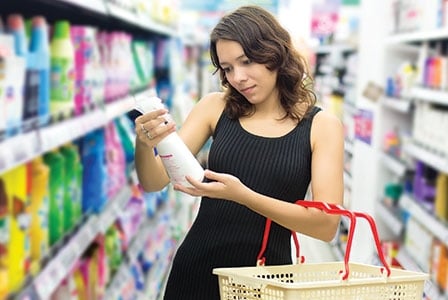
Breast cancer has been linked to toxic chemical exposure. Learn what you can do to minimize your risk.
Some women have a higher risk than others of developing breast cancer because of certain risk factors. For example, they may have a specific gene or a close family member who has had breast cancer. Scientists are learning how our environment can also play a role in increasing a woman’s risk—but there are steps that we can take to help protect ourselves.
Environmental toxins
Researchers have known for a while that more than 200 groups of chemicals can cause breast cancer in animals, 102 of which humans are exposed to fairly regularly. A recent study stressed that 17 of these groups may also cause cancerous tumours in humans and that reducing our exposure to the chemicals (see sidebar page 87) should be a priority.
These chemicals, found throughout our environment, may be hard to avoid. But there are things you can do to reduce your exposure, if not eliminate it all together.
Watch what you eat and how it is prepared
Cook with a good ventilation fan; it will help draw out exhaust. Avoid high-starch foods cooked at high temperatures (such as french fries and potato chips), as well as meats that are cooked at high temperatures (pan frying or grilling over an open flame). Charred foods should be avoided as well.
Avoid inhaling gas fumes and car exhaust
Gas fumes are present when you fill your car or a container at a gas station, or through stored gasoline. Refill containers or gas-powered equipment in well-ventilated areas. Don’t idle your car when waiting in it or to warm it up. As well, use electric or hand-powered tools, such as lawn mowers, rather than gas-operated ones.
Don’t smoke; avoid second-hand smoke
Quit smoking if you smoke; the benefits will begin accruing immediately. You will not only reduce your risk of developing breast cancer, but also reduce risk for other types of cancer (notably of the lungs) as well as for coronary heart disease.
Avoid flame retardants or stain-resistant products
Buy furniture (upholstery and foam) and carpeting that is not treated with flame retardants such as polybrominated diphenyl ethers (PBDEs) or fabric protectors such as Teflon or perfluorooctanoic acid (PFOA). Also avoid foam rug pads, choosing felt, jute, or rubber instead.
Avoid dry cleaners that use perchloroethylene (perc)
Instead, look for cleaners that use “wet cleaning” methods that are gentler on fabrics as well as on your health and that of the environment.
Filter your drinking water with a solid carbon block
Carbon filters can help reduce some contaminants that may be in your water, such as benzene.
Keep harmful chemicals outside
Take your shoes off when you get home. As you walk around outside, the dust and dirt that collect on the bottom of your shoes may contain pollutants such as pesticides and lead. By taking your shoes off at the door, you keep them outside of your home.
Diagnosing breast cancer
Breast cancer can be discovered accidentally (you or your partner feels a lump), through regular screening, or through tests because you have symptoms.
Self-detection
If you notice a suspicious lump or other sign that concerns you, such as sudden changes in one breast (size, colour, or temperature to touch, for example), discharge from the nipple, or breast pain not related to menstruation or a trauma, your health care practitioner may send you for a mammogram, which is the first step to diagnosing—or ruling out—breast cancer.
Screening
For women who don’t have symptoms or increased risk factors, breast cancer may be diagnosed through regular screening. Opinions about breast cancer screening vary, though.
Some experts worry that screening too often can boost the number of false positives, which happen when a radiologist sees something that could be a tumour but turns out not to be. But others argue that regular screening finds breast cancer in its earliest stages, allowing for less invasive and harsh treatments.
In 2011, the Canadian Task Force on Preventive Care issued new guidelines for women at average risk for breast cancer. They say that women between 40 and 49 years old don’t need routine mammograms and those who are between 50 and 74 years old should have a screening mammogram once every two or three years. There were no recommendations for women older than 74 years.
Further testing
If a woman’s mammograms show a suspicious spot or the images aren’t clear, she may be sent for an ultrasound or magnetic resonance imaging (MRI) so a radiologist can have a closer, clearer look at the breast tissue.
If cancer still can’t be ruled out, the next step is usually a biopsy. The first one, a fine-needle aspiration biopsy, is to learn if there are any cancer cells in the suspicious area. A thin needle is inserted into the breast, directly into the lump, so the physician can collect some cells to be sent for testing.
If there are cancer cells in the sample, a core biopsy may be done. This allows cells to be taken from the tumour and the surrounding tissue to see if any cancer cells have spread beyond the tumour. A surgical biopsy may be done instead, especially if the tumour isn’t easily reached for a core biopsy. With a surgical biopsy, part or all of the tumour is removed and sent for testing.
Different women, different cancer: different treatments
Treatments for breast cancer can be quite different, depending on how early or late the cancer was found, how aggressive the cancer is, and how aggressive you and your health care practitioner want to be.
Many women wonder if complementary or alternative medicine (CAM) or therapies may help manage their breast cancer, either by increasing their chances of a cure, helping them manage the effects of the treatments, or helping them relax during one of the most stressful periods of their life.
The CAM umbrella is quite large—there are so many options to choose from, including mind-body techniques, energy therapies, oral therapies, and topical ones. If you choose to use CAM while undergoing treatment, be sure to discuss this with your care team.
For example, radiation can be harsh on the skin. If you apply a product on your skin before receiving radiation, the product could affect the dosage you receive and the radiation’s effect on the skin. If you are receiving chemotherapy, extra vitamins or natural products could affect how the medications act in your body.
The value of CAM
Two studies from the United Kingdom looked at women who turned to CAM during breast cancer treatment. One study looked at how CAM affected a woman’s quality of life during that time, with results showing that most women who used therapies such as yoga and guided imagery found some benefit from them. They said that the CAM helped improve their quality of life.
A second study looked at women who were using CAM while undergoing radiation therapy. Researchers found more than half the women in their study used some sort of complementary therapy; the most common were activity-based therapies, such as yoga.
A diagnosis of breast cancer can be a very frightening time. Luckily, research has come a long way with diagnosis and treatment. And while we may not entirely eliminate the risk of developing the disease, we are learning that there are steps we can take to reduce the risks and take care of ourselves if we are diagnosed with the disease.
17 chemical groups to avoid
| Chemical | Found in |
| 1,3 butadiene | tobacco smoke; car exhaust; gasoline fumes; synthetic rubber and petroleum refining |
| acrylamide | starchy foods, cooked at high temperatures; grouts; adhesives; drinking water treatments |
| aromatic amines | production of polyurethane, pesticides, dyes, and other products |
| benzene | gasoline; tobacco smoke; some adhesive removers; paints; sealants |
| halogenated organic solvents | now less common but still may be found in hairspray propellants, gasoline additives, and paint and spot removers |
| ethylene and propylene oxide | a gas that sterilizes equipment (medical and musical, for example); tobacco smoke; car exhaust |
| flame retardants | polyester resins; plastic polymers; rigid polyurethane foams; flame retardants |
| heterocyclic amines | meat cooked at high temperatures and tobacco smoke |
| certain types of hormone replacements, such as estrogens, progesterone, and diethylstilbestrol (DES) | |
| MX | byproducts of drinking water disinfection |
| nitro-PAHS (polycyclic aromatic hydrocarbons) | diesel exhaust |
| ochratoxin A | contaminated grain, nuts, and pork products |
| PAHS | tobacco smoke; polluted air; charred foods |
| perfluorooctanoic acid (PFOA) | nonstick and stain-resistant coatings; some cosmetics; lubricants; paints; adhesives |
| non-hormonal pharmaceuticals | some medications prescribed for cancer treatment, high blood pressure, fungal infections, and others |
| styrene | tobacco smoke; food that has been in contact with polystyrene |
| others | numerous other chemicals that do not fall into these categories, but are found in pesticides, some dyes, etc. |
CAM for breast cancer
Mind-body, activity, or energy techniques
- meditation
- prayer
- yoga
- massage
- reflexology
- cognitive behaviour therapy
- acupuncture
- reiki
- therapeutic touch
Oral
- high-dose vitamins or herbal products
Topical
- creams and other products for the skin



